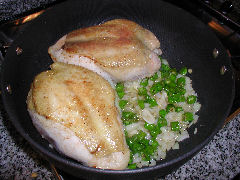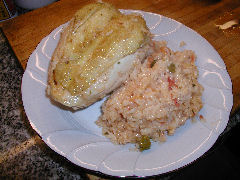“When the Patron of a Paris bistro is a native of Lyon and his wife – who does the cooking – comes from Les Landes, then you may be sure that the quality of both the wine and the food, simple though they may be, are the best. That is what you will find Chez Joséphine, an unpretentious, friendly bistro in a rather out-of-the-way district of Paris, half-way between Napoleon’s tomb and the Gare Montparnasse.
Monsieur and Madame Duranton have been here for over twenty years. The décor has never changed: there are still plalin mirrors on the walls and sawdust on the floor. The zinc, behind which the Patron serves you your apéritif, has been slightly modernised, otherwise the atmosphere and setting has always remained the same.
Artists, doctors, and businessmane like to come here to taste Joséphine’s specialties of Foie-Gras au Naturel, Confits d’Oie, Jambon des Landes, Terrine de Foie de Volaille Truffée, Coq au Vin, and Poularde Portugaise (which should be ordered in advance: the recipe is given here).”
– Alan Watt, Paris Bistro Cookery, 1957
Buenos Aires – Several years ago I found a small tome on a used book cart, probably outside somewhere like the Strand in New York, but I really don’t remember. The book, quoted from above, is an absolute gem – Mr. Watt was an accomplished amateur chef and the food and wine writer for the London Daily Telegraph, as well as a contributor to Vogue, and a co-author with James Beard on one or two of his cookbooks. He spent much of his life in Paris, where he made it his mission to explore the city’s bistros, and learn the secrets of their signature dishes. The book covers fifty of his favorites, along with recipes. I have pulled the book off the shelf regularly since finding it, and each time I’ve made a recipe, even with modifications, it has never failed to be delicious, a testament to both his tastes and the quality of cooking in these classic establishments. My guess is that fifty years later, Chez Joséphine is either gone, or certainly in the hands of someone else.
 I had picked up a couple of whole chicken breasts the other night for dinner, with no real idea what I was going to do with them. I pulled the book down and looked through the half dozen or so recipes for chicken, and the Poularde Portugaise stuck out both because it sounded delicious and because I had all but one of the ingredients, which I ended up leaving out (mushrooms). The recipe called for separate cooking of chicken, sauce, and rice, the end result to be a bed or rice, with a simple half-breast of chicken atop, and the sauce ladled carefully all around. I had a zillion things to do that evening, and decided to go with the flavors, but make it as a simple one-pot dish. Luckily, I have a large dutch oven with a lid!
I had picked up a couple of whole chicken breasts the other night for dinner, with no real idea what I was going to do with them. I pulled the book down and looked through the half dozen or so recipes for chicken, and the Poularde Portugaise stuck out both because it sounded delicious and because I had all but one of the ingredients, which I ended up leaving out (mushrooms). The recipe called for separate cooking of chicken, sauce, and rice, the end result to be a bed or rice, with a simple half-breast of chicken atop, and the sauce ladled carefully all around. I had a zillion things to do that evening, and decided to go with the flavors, but make it as a simple one-pot dish. Luckily, I have a large dutch oven with a lid!
 I made some very minor changes to the ingredients based on what I had – I still had a small bag of those green shishito peppers I used in last weekend’s Casa S dinner, so those substituted for standard green peppers, with much the same flavor, and I had green olive tapenade rather than sliced green olives, and I cut back on the butter (the original recipe used a ½ cup) and increased the olive oil. I browned the chicken breasts in the butter and oil, then added the onion, garlic, and peppers to the pot, cooking them until the onions were just transluscent. Then I added the rice, stirring to coat with the oil, and then the rest of the ingredients down through the wine, along with a couple of cups of water to cook the rice through since I wasn’t doing it separately. Then I covered the whole thing and left it to cook until the rice and chicken were cooked through – at the end, I added the cream and seasoned with parsley, salt and white pepper to taste. Henry, of course, looked at it and declared it a mess and inedible, and then promptly ate a double portion. It was really quite good!
I made some very minor changes to the ingredients based on what I had – I still had a small bag of those green shishito peppers I used in last weekend’s Casa S dinner, so those substituted for standard green peppers, with much the same flavor, and I had green olive tapenade rather than sliced green olives, and I cut back on the butter (the original recipe used a ½ cup) and increased the olive oil. I browned the chicken breasts in the butter and oil, then added the onion, garlic, and peppers to the pot, cooking them until the onions were just transluscent. Then I added the rice, stirring to coat with the oil, and then the rest of the ingredients down through the wine, along with a couple of cups of water to cook the rice through since I wasn’t doing it separately. Then I covered the whole thing and left it to cook until the rice and chicken were cooked through – at the end, I added the cream and seasoned with parsley, salt and white pepper to taste. Henry, of course, looked at it and declared it a mess and inedible, and then promptly ate a double portion. It was really quite good!
Poularde Portugaise
As I made it…Brown:
2 whole chicken breasts in
3 tablespoons of olive oil
2 tablespoons of butterAdd and cook for a few minutes:
1 large onion, chopped
2 cloves of garlic, sliced
1 dozen sliced shishito peppersAdd, stir, cover and cook until rice and chicken are done:
1 cup of rice
4 tomatoes, crushed
¼ cup of green olive tapenade
½ cup of dry white wine
2 cups of waterTo finish, remove chicken and add:
½ cup of cream
chopped parsley
salt and white pepperServe and enjoy!
From one of my local readers, Mary:
googling your latest entry, this came up:
Bonjour Paris
LesRestos.com
enjoy this great sunday in our likewise city
How cool is that?
[…] Buenos Aires – Fricassée refers both to a dish as well as a cooking method. A chicken fricasée is made by sauteeing the chicken in butter then stewing the meat along with vegetables until the liquid around it becomes a thick sauce. Maybe it’s that spring is in the air here. I find myself delving more and more into the Paris Bistro Cookery book I mentioned a couple of weeks ago, and making my own adaptations. Who makes a fricasée? Who even knows what one is? Has anyone besides a character in a Bugs Bunny cartoon even used the word in the last half century? I can tell you, around these parts, it’s going to start getting used a whole lot more! Poulet en Fricasée à la Lyonnaise […]
How interesting that I found your site – I have the exact same cookbook, found at a book sale in Virginia. It is one of my treasured gems – my favorites are the classic crepe recipe and the clafouti recipe.
[…] many moons ago I was playing around with a classic French bistro recipe for Poulard Portugaise. Here, a complete reinterpretation, or perhaps simply a dish inspired by the flavors of that plate. […]
[…] of my favorite French bistro dishes is poularde portugaise, the recipe here. A few differences from that recipe – Chicken thighs instead of breasts because I wanted it […]